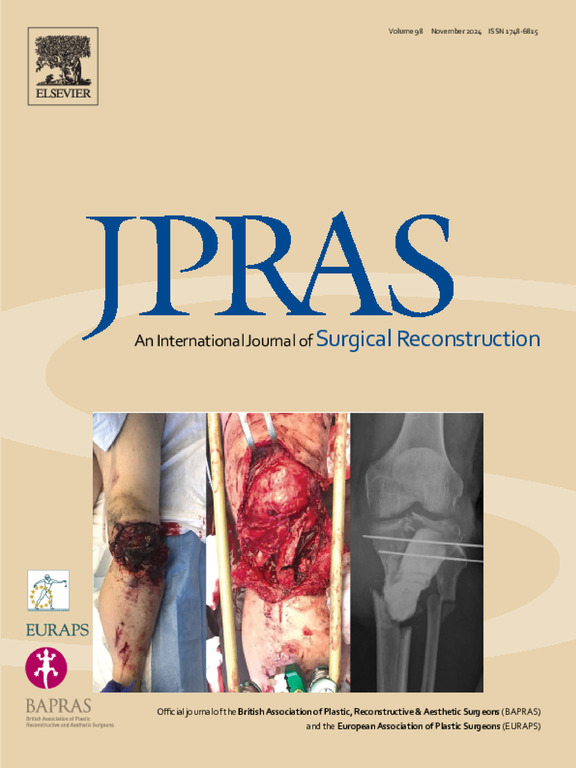Post-operative complications in combined versus staged breast reconstruction and risk-reducing gynecologic surgeries: A multi-institution multi-surgeon analysis
IF 2.4
3区 医学
Q2 SURGERY
Journal of Plastic Reconstructive and Aesthetic Surgery
Pub Date : 2025-07-01
DOI:10.1016/j.bjps.2025.06.033
引用次数: 0
Abstract
Background
Combined breast reconstruction and risk-reducing gynecologic procedures (RRGPs) have emerged as an alternative to the traditional staged approach, offering potential advantages such as reduced cumulative surgical burden and streamlined recovery. However, conflicting outcomes in the literature highlight the need for multi-institutional analyses to guide clinical decision-making.
Methods
This multi-institutional, retrospective cohort study evaluated postoperative complications within 90 days of surgery among patients undergoing combined versus staged breast reconstruction and RRGPs. Data from three academic centers spanning 2010 to 2023 were analyzed. The primary outcome was the occurrence of complications, stratified by reconstruction type and gynecologic procedures. Secondary outcomes included emergency department visits, reoperations, readmissions, and hospital length of stay. Multivariable analyses controlled for confounding variables, including BMI, prior radiation therapy, and comorbidities.
Results
Among 348 patients, 96 underwent combined procedures and 252 underwent staged procedures. Overall complication rates were comparable between groups after adjustment (adjusted OR: 0.85, 95% CI: 0.66–1.10, p = 0.220). Combined procedures were associated with shorter operative times and hospital stays compared to staged surgeries (median 296 vs. 386 min, p < 0.001; mean: 1 day vs. 2 days, p < 0.001). Subgroup analysis revealed a significantly higher risk of seroma/hematoma in tissue expander-based reconstruction within the combined cohort (45% vs. 13%, p = 0.020), while direct-to-implant and autologous reconstructions had similar complication rates between groups. Gynecologic complications were infrequent and did not differ significantly between cohorts.
Conclusions
Combined procedures provide a viable alternative to staged approaches, offering logistical advantages without increasing overall complication rates. Careful patient selection and perioperative planning remain critical, particularly for tissue expander-based reconstruction, where complication risk may be higher in combined surgeries. Further prospective studies are needed to refine patient selection criteria and optimize outcomes.
联合与分期乳房重建和降低风险的妇科手术的术后并发症:一项多机构、多外科医生的分析。
背景:联合乳房重建和降低风险的妇科手术(RRGPs)已经成为传统分期手术的替代方案,具有减少累积手术负担和简化恢复等潜在优势。然而,文献中相互矛盾的结果强调需要多机构分析来指导临床决策。方法:这项多机构、回顾性队列研究评估了接受联合乳房重建和分期乳房再造的患者术后90天内的并发症。来自三个学术中心的数据从2010年到2023年进行了分析。主要结果是并发症的发生,根据重建类型和妇科手术分层。次要结局包括急诊科就诊、再手术、再入院和住院时间。多变量分析控制混杂变量,包括BMI、既往放射治疗和合并症。结果:在348例患者中,96例接受了联合手术,252例接受了分期手术。调整后两组间的总并发症发生率具有可比性(调整后OR: 0.85, 95% CI: 0.66-1.10, p = 0.220)。与分阶段手术相比,联合手术与更短的手术时间和住院时间相关(中位296分钟vs 386分钟,p < 0.001;平均:1天vs. 2天,p < 0.001)。亚组分析显示,在联合队列中,基于组织扩张器的重建术发生血肿/血肿的风险明显更高(45% vs. 13%, p = 0.020),而两组间直接植入和自体重建术的并发症发生率相似。妇科并发症不常见,在队列之间没有显著差异。结论:联合手术是分期手术的可行选择,在不增加总体并发症发生率的情况下提供了后勤优势。谨慎的患者选择和围手术期计划仍然至关重要,特别是对于基于组织扩张器的重建,联合手术的并发症风险可能更高。需要进一步的前瞻性研究来完善患者选择标准和优化结果。
本文章由计算机程序翻译,如有差异,请以英文原文为准。
求助全文
约1分钟内获得全文
求助全文
来源期刊
CiteScore
3.10
自引率
11.10%
发文量
578
审稿时长
3.5 months
期刊介绍:
JPRAS An International Journal of Surgical Reconstruction is one of the world''s leading international journals, covering all the reconstructive and aesthetic aspects of plastic surgery.
The journal presents the latest surgical procedures with audit and outcome studies of new and established techniques in plastic surgery including: cleft lip and palate and other heads and neck surgery, hand surgery, lower limb trauma, burns, skin cancer, breast surgery and aesthetic surgery.

 求助内容:
求助内容: 应助结果提醒方式:
应助结果提醒方式:


